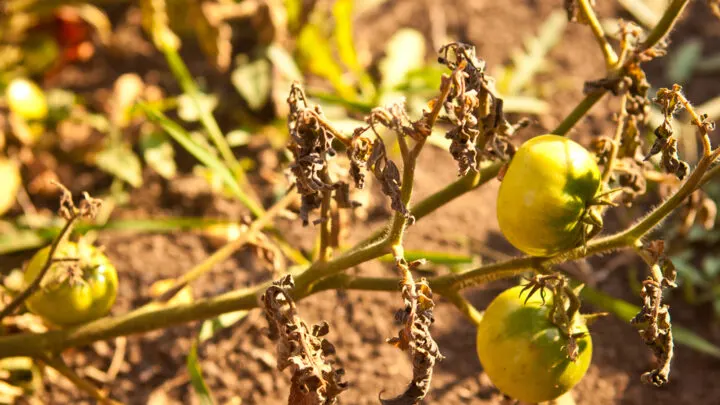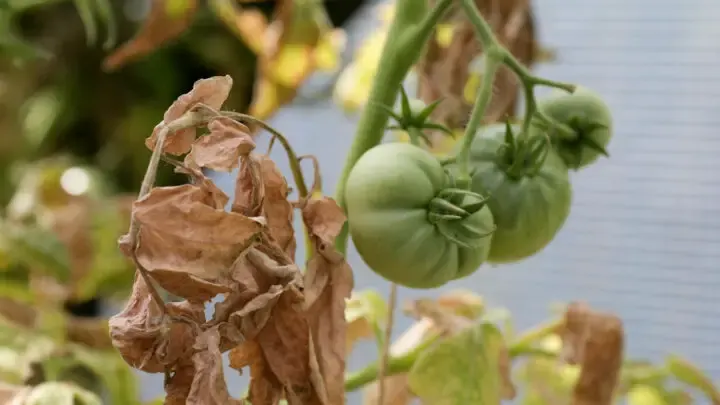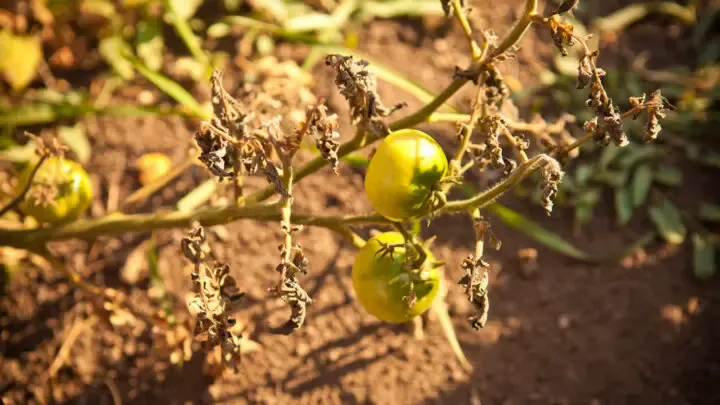This is the plant as a whole, not just the leaves. Describe stems drying up, fruits, leaves, roots, all of it.
Tomato plants might be a popular garden plant. Still, they’re also notorious for drying up and having unexpected problems that are difficult to solve and can get in the way of having a good harvest.
Drying is one of the most common tomato plant problems and can plague even the most experienced gardeners. But, why do tomato plants dry up?
Tomatoes typically dry up when they lack sufficient watering. Everything from pests like aphids to disease, and fungus in the soil can cause different symptoms and lead to tomatoes drying up.
There are many reasons tomato plants dry up, and it can sometimes be hard to figure out the root cause of the problem. Here’s a quick guide to tomato plant drying and what you can do to help your tomato plant recover from drying.

Reasons Tomato Plants Dry Up
There are dozens of reasons that tomato plants can dry up, but chances are that your garden is only affected by a couple of them. In this section, let’s talk about some of the most common reasons your tomatoes can dry up, and then in the next section, we’ll talk about the symptoms of drying and how different kinds of drying can help you diagnose and fix the problem.
Underwatering Your Tomatoes
Underwatering is probably the single most common cause of tomato plant drying. Tomatoes need roughly an inch of water per week to thrive and sometimes need more because of dry conditions, intense sunlight, or high heat.
Increasing water slowly until your tomatoes are thriving again is the easiest solution, but be careful not to flood them or wash all their nutrients out of the soil.
Pests Are Stealing Your Tomato Plant’s Resources
Insects like aphids can also take a healthy tomato plant and turn it into a dried, diseased mess and do it relatively quickly.
The first step to solving this problem is diagnosing it. Check the undersides of your tomato plant’s leaves for aphids, and look for chewed areas and other tell-tale signs of caterpillars, slugs, and other pests.
While pesticides are often the fastest option for treating tomato pests, you may also want to consider getting ladybugs or praying mantis from your local garden center. Predators can be a good deterrent.
Alternatively, you can plan your gardens with companion plants and pest-deterring herbs and flowers to reduce the risk of tomato pests.

Disease And Fungi Attacks
There is a wide range of plant diseases and pest problems that can affect your tomato plants, from powdery mildew to root rot.
Some of these diseases are treatable; others call for removing your plant from the garden and destroying it.
In some cases, like when your tomatoes have blight or leaf spots, you can aggressively remove the infected areas and then treat the rest of the plant to prevent spread. However, in the case of diseases like Fusarium Wilt and Verticillium Wilt, not only will you need to dispose of the infected plant, you may need to relocate your garden in the future to prevent the disease from coming back.
Poor Soil Nutrient Content
The last reason we want to touch on is a simple lack of nutrition. When soil nutrition levels drop too low, your tomato plants can struggle to get the nutrients they need for good growth and even proper circulation inside the plant.
That lack of circulation can cause severe wilting, especially wilts that involve leaves and stems.
The fix is relatively simple, add fertilizer and/or compost to your garden beds. However, fertilizer or compost will take some time to fix the problem.
Short term, consider making a calcium supplement by soaking eggshells in apple cider vinegar overnight. Dilute the mixture with water, and spray it on the ground around the plants. Water as normal.
Banana peel tea and used coffee grounds are good emergency nutrient boosts, but you shouldn’t use these remedies too often because they can change your soil’s PH.

How To Tell Why Your Tomato Plants Dry Up
Now that you know a little more about why tomato drying happens let’s talk about different kinds of tomato drying and what they’re telling you.
Dry Yellowing Leaves
Dry yellowing leaves are usually the easiest form of tomato drying to fix and tend to have the simplest cause.
In this case, you most likely need to increase the water your tomatoes are getting, the number of nutrients in the soil, or both.
The exception to this is if your tomato has caught blight or a wilt disease, both of which can look like simple drying at first. Watch for dark browning spots in your tomato’s leaves and signs of stem weakness, especially if the stems are drying in a different location from the leaves.
Another sign that the problem might be disease-born instead of related to water and nutrition is if the wilting seems to start closer to the soil or in the middle of the plant instead of the extremities. In this case, you should also check soil moisture to ensure you aren’t overwatering and accidentally causing root rot.
If nothing works, unfortunately, this may have been a case of blight or wilt, and you’ll need to treat the soil or relocate your garden next year.
Dry Shiny Or Splotchy Leaves
Dry shiny leaves are one of the classic signs of an out-of-control aphid infestation.
First, check your tomato for insects. If they’re there, consider using insecticidal soap as an immediate remedy that can be reapplied. Predators like ladybugs may be an effective long-term control option.
Splotchy leaves, predominantly yellow and brown, are signs of blight and wilt diseases. Watch your tomatoes carefully to see if other plants are affected. You might have caught it early enough to treat it if it’s just one plant.
Remove the infected areas and treat with sulfur for suspected blight. If the symptoms look like wilt, remove the plant from your garden and monitor the other tomato plants and nightshades for signs of the same condition.

Drying Stems
Drying stems may signify that your tomatoes are underwatered and have been for a long time, but they’re usually a sign of a more severe disease cause.
Check the soil to see if it’s too damp, and check to see if the area around the drying stem seems damp or moldy; mold damage can often look like dryness when it’s excess moisture causing the problem.
Both forms of fungal wilt may also cause leaf wilt, followed by drying/brown stems. In the absence of other known causes, wilt is likely the problem.
Remember, tomato wilt diseases can last for years in infected soil and affect many nightshade vegetables and other fruiting plants like strawberries.
Drying Flowers/Fruit Buds
Dry tomato flowers are one of the most frustrating kinds of drying, especially if it’s happening on an otherwise healthy plant.
Unfortunately, this problem is most likely environmental. Flowers may dry up if it’s too humid for effective pollination or if there is too much wind drying the delicate petals and inner parts of the flowers.
Hand-pollinating can help with the first problem, and setting up a windscreen or waiting for calmer conditions can solve the second problem.
Whole Plant Drying
Whole plant drying needs to be narrowed down depending on where the wilting and drying started and what other symptoms are present.
A green or yellowing tomato plant may need more water and additional nutrition support, especially if it’s wilting and drying on hot days or just before watering.
However, if a plant wilts suddenly, don’t come back within a couple of hours after watering, and has no signs of pests, this can signify that you have a faster-acting Fusarium Wilt. Fusarium Wilt is more common in hot weather but can appear at almost any point in your tomato plants’ growth cycle.
Most of the time, if your plants are drying, underwatering, or pests will be to blame. However, wilts and other fungal diseases may come back year after year unless you relocate your garden or scrape and replace the soil.

Hi there, my name is Allie and welcome to my blog; GareningWithAllie!
Much of what you see written here is just our personal experiences with gardening. Along with the content I write here, there is also a unique collection of gardening topics covered by some of our close friends. I hope you find everything you read here to be helpful, informative, and something that can make your gardening journey the most lovely experience ever! With that said, Happy Gardening!
